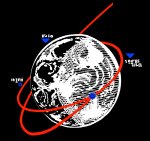
Technology in the Empire
Faster-than-Light Travel
There are two known forms of Faster-Than-Light travel: Jump Drive and Jump Gates.
The Jump Drive
2193: The First Extrasolar FlightEarth's first major jump excursion was to the neighbouring Alpha Centauri star system -- just over four light years away. This mission was accomplished using Jump2 technology developed by the European Space Agency, and the journey took almost fourteen months. The trip confirmed suspicions that a habitable extra-solar planet existed in the Centauri system. Almost two years after the original flight launched, The Endeavor, a giant ship, carrying three hundred colonists began their fourteen-month journey to Centauri. Most of the travellers spent the journey asleep in a bacterial-killing gel; they arrived bald and itchy from the chemical agents, but ready to build a new world. The original crew of the colony ship was not supposed to stay on the planet, but a technical fault disabled the Jump drive, and they were forced to stay with the colonists. Earth had intended to reuse the original colony ship, and it took several years before a second was constructed (especially considering the expense). In that time, the first colony saw many hardships, and almost died out, but when a new colony ship arrived in 2202, 190 of the original colonists were waiting there to greet them. The Centauri colony world -- Poseidon -- is now the largest extrasolar Terran colony, and is one of the few colonies that has been recognized as an independant political entity. |
Faster-than-light travel was first discovered in the Terran realm shortly after the discovery of a metal called liminalium. When very large amounts of electricity is run through liminalium, a field -- a liminal field -- is created.
This liminal field opens a small hole between our space and another dimension (known alternately as "hyperspace" or "jump space"). If a ship has a grid of liminalium on its outer skin, you can open a ship-sized hole, and allow the ship to enter hyperspace, travel some distance, and re-emerge at a different point.
Because there isn't a one-to-one mapping between hyperspace and normal space, one emerges from hyperspace having travelled considerably further than one could travel in the same time through normal space.
Thus, for example, a Terran passenger liner leaving Earth can point itself toward Alpha Centauri, enter hyperspace for approximately six days, and then re-emerge from hyperspace some distance from a Centauri colony world.
The maximum "speed" possible depends on technology and comprehension of hyperspace astrogation. As one gains a better understanding of hyperspace, one is capable of deeper and deeper journeys through hyperspace, resulting in faster overall speed, relative to normal space.
Currently, the fastest native Terran jump engines are capable of speeds up to 250 times the speed of light; these engines are classified Jump8 (28 = 256). The Empire is known to have much faster engines (Jump11 or Jump12).
One of the limiting factors of Jump travel is the fact that hyperspace navigation is extremely complicated. The mathematical equations required to navigate hyperspace grow exponentially the farther one travels through hyperspace. Terran computers are incapable of remaining in hyperspace beyond the equivalent of eight light years. Even the Empire is incapable of exceeding 32 light years.
This navigational restraint imposes a significant limitation on the effective range of starships. Because of the exceptional energy required for a jump engine to generate the liminal field, very few ships are capable of multiple "hops"; in general, ships are limited to one jump between refuelings.
Commercial Jump Travel
The model for commercial jump travel is almost identical in both the Terran realm and the Empire. A number of standard "Jump Routes" have been established at any given world. Typically a ship would:
- Purchase a standard navigational plot to the destination world.
- Register a flight plan with the Traffic Authority at the world's starport.
- Follow a standard "flight lane" toward a designated jump point. These jump points are generally hundreds of thousand kilometres from the planet's surface.
- Activate the jump drive.
- Emerge from jump space in the destination star system.
A starport's Traffic Authority makes careful plans to ensure that ships are nowhere near one another when entering or emerging from hyperspace. It's also true that because most traffic enters and departs a system in selected areas, it's easier to police the space against pirates and terrorists.
Jump Gates
Jump Gates are native to neither the Terran Realm nor the Empire. A handful of permanent tunnels through hyperspace were created by the Rheri 50,000 years ago, and remain operational today. Travel through the gates is almost instantaneous, and requires no energy from the ship itself. The science of Jump Gates is not understood, but the Gates are a staple of interstellar travel in the Empire.